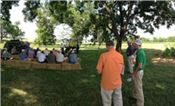Forage Management: A Simple Way To Calibrate Sprayers

DR. GARY BATES
KNOXVILLE, TENN.
November and December are good months to control most of the cool- season weeds found in our pastures and hayfields. Not only is the ground less muddy compared to spring, but weeds are growing and sensitive to herbicides during the fall and early winter. Before you can accurately apply the right amount of herbicide to a field, you have to know how much spray mix is being applied to each acre. This will help you determine how many acres you can cover with one tank, and how much herbicide to add to each tank. Sprayer calibration is not difficult, but it can be challenging if you have never seen it done before. Here are simple methods to calibrate a boom and boomless sprayer.
Boom Sprayer
• Measure out course in field to be sprayed.
• Measure time (in seconds) to drive course. Use a comfortable gear and speed. Take the average of three trips. Make note of engine speed (rpm)
• Park tractor with engine running at same rpm and catch the output from one nozzle for the time found in step 3.
• Measure output from one nozzle in ounces. This will equal sprayer output in gallons per acre.
• Determine acres that can be covered with tank. This will be tank volume (gallons) divided by sprayer output (gallons from step 5) • Multiply acres from step 6 by desired herbicide rate. This will give the amount of herbicide to add to full tank.
Boomless Sprayer
• Measure out course in field to be sprayed.
• Measure time to drive course. Use a comfortable gear and speed.
Take the average of three trips. Make note of engine speed (rpm)
• Park tractor with engine running at same rpm, put garbage bag around nozzle and catch the output for the time found in step 3.
• Measure in pints. This will equal sprayer output in gallons per acre.
• Determine acres that can be covered with tank. This will be tank volume (gallons) divided by sprayer output (gallons from step 5) • Multiply acres from step 6 by desired herbicide rate. This will give the amount of herbicide to add to full tank. ∆
DR. GARY BATES: Director and Professor, UT Beef & Forage Center, University of Tennessee
BOOM SPRAYER
Select a course length based on nozzle spacing (from chart below) Nozzle spacing
(inches) 20 22 24 26 28 30 32 34 36 38
Course
length
(feet) 204 185 170 157 146 136 127 120 113 107
BOOMLESS SPRAYER
Select a course length based on spray swath width (from chart below) Spray width
(feet) 30 32 34 36 38 40 42 44
Course
length
(feet) 182 171 161 152 144 137 130 124
*if your sprayer’s spray width is not listed, divide 5460 by your spray width to get travel distance.